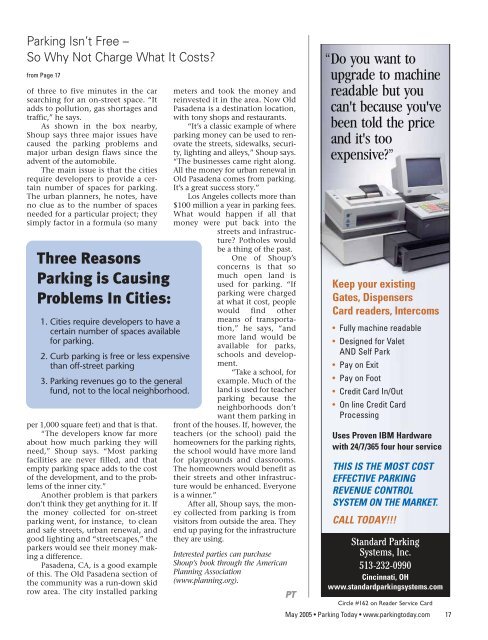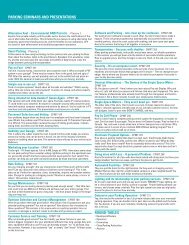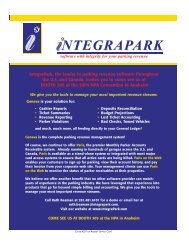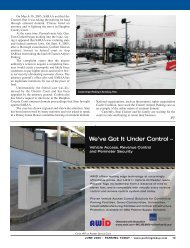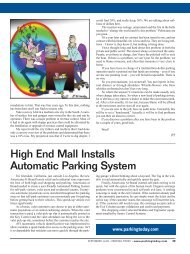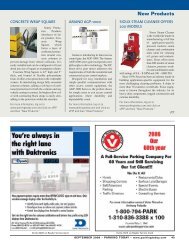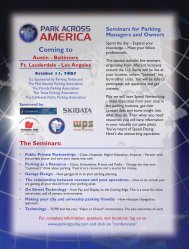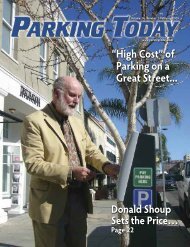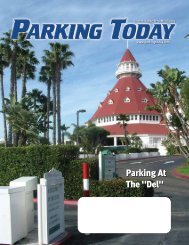Three Reasons Parking is Causing Problems In Cities - Parking Today
Three Reasons Parking is Causing Problems In Cities - Parking Today
Three Reasons Parking is Causing Problems In Cities - Parking Today
Create successful ePaper yourself
Turn your PDF publications into a flip-book with our unique Google optimized e-Paper software.
<strong>Parking</strong> Isn’t Free –<br />
So Why Not Charge What It Costs?<br />
from Page 17<br />
of three to five minutes in the car<br />
searching for an on-street space. “It<br />
adds to pollution, gas shortages and<br />
traffic,” he says.<br />
As shown in the box nearby,<br />
Shoup says three major <strong>is</strong>sues have<br />
caused the parking problems and<br />
major urban design flaws since the<br />
advent of the automobile.<br />
The main <strong>is</strong>sue <strong>is</strong> that the cities<br />
require developers to provide a certain<br />
number of spaces for parking.<br />
The urban planners, he notes, have<br />
no clue as to the number of spaces<br />
needed for a particular project; they<br />
simply factor in a formula (so many<br />
<strong>Three</strong> <strong>Reasons</strong><br />
<strong>Parking</strong> <strong>is</strong> <strong>Causing</strong><br />
<strong>Problems</strong> <strong>In</strong> <strong>Cities</strong>:<br />
1. <strong>Cities</strong> require developers to have a<br />
certain number of spaces available<br />
for parking.<br />
2. Curb parking <strong>is</strong> free or less expensive<br />
than off-street parking<br />
3. <strong>Parking</strong> revenues go to the general<br />
fund, not to the local neighborhood.<br />
per 1,000 square feet) and that <strong>is</strong> that.<br />
“The developers know far more<br />
about how much parking they will<br />
need,” Shoup says. “Most parking<br />
facilities are never filled, and that<br />
empty parking space adds to the cost<br />
of the development, and to the problems<br />
of the inner city.”<br />
Another problem <strong>is</strong> that parkers<br />
don’t think they get anything for it. If<br />
the money collected for on-street<br />
parking went, for instance, to clean<br />
and safe streets, urban renewal, and<br />
good lighting and “streetscapes,” the<br />
parkers would see their money making<br />
a difference.<br />
Pasadena, CA, <strong>is</strong> a good example<br />
of th<strong>is</strong>. The Old Pasadena section of<br />
the community was a run-down skid<br />
row area. The city installed parking<br />
meters and took the money and<br />
reinvested it in the area. Now Old<br />
Pasadena <strong>is</strong> a destination location,<br />
with tony shops and restaurants.<br />
“It’s a classic example of where<br />
parking money can be used to renovate<br />
the streets, sidewalks, security,<br />
lighting and alleys,” Shoup says.<br />
“The businesses came right along.<br />
All the money for urban renewal in<br />
Old Pasadena comes from parking.<br />
It’s a great success story.”<br />
Los Angeles collects more than<br />
$100 million a year in parking fees.<br />
What would happen if all that<br />
money were put back into the<br />
streets and infrastructure?<br />
Potholes would<br />
be a thing of the past.<br />
One of Shoup’s<br />
concerns <strong>is</strong> that so<br />
much open land <strong>is</strong><br />
used for parking. “If<br />
parking were charged<br />
at what it cost, people<br />
would find other<br />
means of transportation,”<br />
he says, “and<br />
more land would be<br />
available for parks,<br />
schools and development.<br />
“Take a school, for<br />
example. Much of the<br />
land <strong>is</strong> used for teacher<br />
parking because the<br />
neighborhoods don’t<br />
want them parking in<br />
front of the houses. If, however, the<br />
teachers (or the school) paid the<br />
homeowners for the parking rights,<br />
the school would have more land<br />
for playgrounds and classrooms.<br />
The homeowners would benefit as<br />
their streets and other infrastructure<br />
would be enhanced. Everyone<br />
<strong>is</strong> a winner.”<br />
After all, Shoup says, the money<br />
collected from parking <strong>is</strong> from<br />
v<strong>is</strong>itors from outside the area. They<br />
end up paying for the infrastructure<br />
they are using.<br />
<strong>In</strong>terested parties can purchase<br />
Shoup’s book through the American<br />
Planning Association<br />
(www.planning.org).<br />
PT<br />
“ Do you want to<br />
upgrade to machine<br />
readable but you<br />
can't because you've<br />
been told the price<br />
and it's too<br />
expensive?”<br />
Keep your ex<strong>is</strong>ting<br />
Gates, D<strong>is</strong>pensers<br />
Card readers, <strong>In</strong>tercoms<br />
• Fully machine readable<br />
• Designed for Valet<br />
AND Self Park<br />
• Pay on Exit<br />
• Pay on Foot<br />
• Credit Card <strong>In</strong>/Out<br />
• On line Credit Card<br />
Processing<br />
Uses Proven IBM Hardware<br />
with 24/7/365 four hour service<br />
THIS IS THE MOST COST<br />
EFFECTIVE PARKING<br />
REVENUE CONTROL<br />
SYSTEM ON THE MARKET.<br />
CALL TODAY!!!<br />
Standard <strong>Parking</strong><br />
Systems, <strong>In</strong>c.<br />
513-232-0990<br />
Cincinnati, OH<br />
www.standardparkingsystems.com<br />
Circle #162 on Reader Service Card<br />
May 2005 • <strong>Parking</strong> <strong>Today</strong> • www.parkingtoday.com 17
AVI – A Case Study<br />
Eastman Kodak Co.<br />
E<br />
astman Kodak Co. <strong>is</strong> the world leader in helping<br />
people take, share, enhance, preserve, print and<br />
enjoy pictures -- for memories, for information, for<br />
entertainment. With sales of $13.3 billion in 2003, the<br />
company compr<strong>is</strong>es several businesses:<br />
• Health, supplying the healthcare industry with traditional<br />
and digital image capture and output products and<br />
services.<br />
• Graphic Communications Group, offering on-demand<br />
color printing and networking publ<strong>is</strong>hing systems, cons<strong>is</strong>ting<br />
of three wholly owned subsidiaries: Encad <strong>In</strong>c., Nex-<br />
Press Solutions and Kodak Versamark.<br />
• Commercial Imaging, offering image capture, output<br />
and storage products and services to businesses and government.<br />
• D<strong>is</strong>play and Components, which designs and manufactures<br />
state-of-the-art organic light-emitting diode d<strong>is</strong>plays,<br />
as well as other specialty materials, and delivers<br />
imaging sensors to original equipment manufacturers.<br />
• Digital and Film Imaging Systems, providing consumers,<br />
professionals and cinematographers with digital<br />
and traditional products and services.<br />
Perimeter Security Challenges<br />
Kodak had a growing need to identify vehicles at long<br />
d<strong>is</strong>tances to secure its security perimeter and to control<br />
access to parking facilities and loading dock areas within its<br />
Rochester, NY, corporate campus.<br />
Deployment of an automatic vehicle identification<br />
(AVI) system was the latest step in an ongoing implementation<br />
of state-of-the-art security measures at Kodak. An additional<br />
requirement to th<strong>is</strong> phase of the project was compatibility<br />
with the company’s new employee access control<br />
cards from HID.<br />
Finding a Solution<br />
Thomas Rohr, Kodak’s Manager of Protective Services<br />
for worldwide corporate security, was aware of a new system<br />
incorporating HID Prox card-compatible in-vehicle<br />
readers and transmitter devices. Because part of the Kodak<br />
systems upgrade had included the deployment of Duo-Prox<br />
cards for all company employees, the ability to use the card<br />
in the NEDAP device to identify employee drivers at d<strong>is</strong>tances<br />
of up to 33 feet at high speeds (more than 100 miles<br />
per hour), while also receiving a vehicle ID was very compelling.<br />
<strong>In</strong> subsequent design d<strong>is</strong>cussions, a plan to use a selection<br />
of inter-compatible AVI tags was formulated. The two<br />
tags to be deployed would be the HID dual-ID Combi<br />
Booster and the single-ID Window Button. Each device<br />
would serve a specific requirement.<br />
The Combi Booster would be used anywhere that a<br />
vehicle would be required to pass through a secure perimeter.<br />
<strong>In</strong> th<strong>is</strong> case, it was decided that the unit’s ability to identify<br />
both the driver by h<strong>is</strong> or her Kodak-<strong>is</strong>sued Prox Card<br />
and the vehicle by its embedded vehicle ID in the Combi<br />
Booster itself was of<br />
paramount importance.<br />
<strong>In</strong> areas such as<br />
Kodak parking facilities,<br />
it was determined<br />
that the convenience<br />
of a longd<strong>is</strong>tance<br />
read afforded<br />
by all the AVI tags<br />
Kodak Headquarters in Rochester, NY.<br />
was beneficial from a throughput perspective while still<br />
providing electronic controlled access. As a result, the single-ID<br />
Window Button was chosen.<br />
All tags are compatible with the same reader, and as a<br />
result, the back-end system could be programmed to grant<br />
access to either type of tag.<br />
After extensive experimentation with various kinds of<br />
AVI equipment, Kodak determined that the NEDAP equipment<br />
with its HID card compatibility and cons<strong>is</strong>tent longrange<br />
detection provided an optimum solution for a complete<br />
rollout in all areas requiring automated vehicle ID.<br />
The system was an extension of the company’s goal to<br />
automate presence-sensing to quickly identify exceptions<br />
and aberrations related to vehicle access.<br />
Another important factor in the dec<strong>is</strong>ion was the ability<br />
to seamlessly integrate all the new employee ID badges<br />
with the vehicle-mounted reader transmitter device. That<br />
several different but compatible AVI tags were available to<br />
address different requirements within the operation also<br />
became an important part in ensuring that the system<br />
would offer enough flexibility for future interoperability,<br />
implementation and expansion.<br />
With a solid long-range vehicle-detection system in<br />
place, Kodak continues to enhance traditional access control<br />
methods with state-of-the-art electronic technology.<br />
With the new AVI system’s ability to seamlessly integrate<br />
with its Matrix Frontier <strong>In</strong>tegrated Security System,<br />
data and access privileges can now be reliably controlled<br />
from Kodak’s central security system. The AVI dual-ID system<br />
was easily integrated into the security back-end system<br />
by assigning a two-badge rule to every Combi Booster<br />
access event.<br />
Kodak <strong>is</strong> so pleased with the new implementation that<br />
it <strong>is</strong> actively pursuing additional applications of th<strong>is</strong> product<br />
as a global solution.<br />
System Implementation Benefits<br />
The implementation of the new system provided several<br />
additional benefits to Kodak, according to Tom Rohr:<br />
“The new AVI system allows vehicles to activate gates<br />
and doors far enough in advance to eliminate the need to<br />
stop. Th<strong>is</strong> reduces a critical and potential security choke<br />
point at the company’s vehicle entrances.<br />
“Safety <strong>is</strong> being improved by eliminating the need for<br />
drivers to reach out a vehicle window for a stationary reader,<br />
typically associated with card-only vehicle access.”<br />
PT<br />
18<br />
May 2005 • <strong>Parking</strong> <strong>Today</strong> • www.parkingtoday.com
New Perspectives in <strong>Parking</strong><br />
and Revenue Control… Think Blue!<br />
Our primary focus <strong>is</strong> customer sat<strong>is</strong>faction through professional project<br />
management, comprehensive service delivery, and custom-engineered<br />
solutions. IT solutions for parking: ZMS, our Zeag Management System,<br />
<strong>is</strong> the perfect management tool from the simplest to the most complex<br />
parking and revenue control requirement.<br />
<strong>In</strong>tegrated solutions: Our Orion system architecture <strong>is</strong> comprehensive,<br />
yet has the flexibility to facilitate the integration of any complimentary<br />
control technologies. Globally local: Zeag and our local partners.<br />
We guarantee flawless quality, unmatched system reliability, and superb<br />
technical support... worldwide.<br />
Zeag North America <strong>In</strong>c., 1-2900 Argentia Road, M<strong>is</strong>s<strong>is</strong>sauga ON L5N 7X9 Canada<br />
Telephone: 905.813.1966 Toll Free: 877.791.1121 Facsimile: 905.813.1952 www.zeag.com<br />
Circle #247 on Reader Service Card - See us at the IPI Booth #1325
Accept the Challenge …<br />
Experience the Rewards: The<br />
T<br />
he <strong>In</strong>ternational <strong>Parking</strong> <strong>In</strong>stitute has <strong>is</strong>sued an<br />
invitation to “Challenge 2005” on May 22-25 in<br />
Fort Lauderdale.<br />
“Challenge 2005” <strong>is</strong> the largest, most comprehensive<br />
meeting of parking professionals held in the United States,<br />
and <strong>is</strong> a key opportunity for parking professionals to coordinate<br />
and gather information, as well as share important<br />
strategies with colleagues.<br />
<strong>Parking</strong> professionals are facing greater challenges than<br />
ever. Technology has revolutionized the industry, while<br />
public demand and expectations are increasing almost daily.<br />
The IPI invites you to accept the challenge and experience<br />
the rewards of building a profession through networking<br />
with peers, while enhancing your professional education,<br />
personal growth and commitment.<br />
The powerhouse of programming will take place at the<br />
Greater Fort Lauderdale/Broward County Convention Center,<br />
and the IPI <strong>is</strong> dedicated to providing the leadership,<br />
education, technical resources and information to meet<br />
these ever growing expectations and challenges.<br />
Exhibit Schedule<br />
So Many Companies -- So Little Time<br />
Sunday, May 22 – noon to 3:30 p.m.<br />
Monday, May 23 – 9:30 a.m. to 12:30 p.m.<br />
– 3:30 to 6:30 p.m.<br />
Tuesday, May 24 – 10 a.m. to 2 p.m.<br />
For electronic floor plans, go to the IPI web site:<br />
www.parking.org<br />
You will experience four full days of intensive educational<br />
programming, “early-bird” programs, ShopTalk d<strong>is</strong>cussion<br />
groups and guided parking tours. Plus, more than<br />
200 exhibiting companies will be d<strong>is</strong>playing the latest<br />
industry technology.<br />
The exhibits will be held in the newly expanded<br />
600,000-square-foot state-of-the-art Convention Center.<br />
Located in Port Everglades, the world’s premier cru<strong>is</strong>e port,<br />
it <strong>is</strong> just five minutes from Fort Lauderdale/Hollywood<br />
<strong>In</strong>ternational Airport. Within walking d<strong>is</strong>tance of the Marriott<br />
Marina and the Embassy Suites, the Convention Center<br />
<strong>is</strong> a short ride to Fort Lauderdale’s palm tree-fringed,<br />
brick-lined beachfront promenade with numerous sidewalk<br />
café type of restaurants, including the world famous “Elbo<br />
Room,” shops and “Beach Place.”<br />
The IPI looks forward to seeing you in Fort Lauderdale. So do<br />
your colleagues. For detailed information on “Challenge<br />
2005,” including the full program, v<strong>is</strong>it<br />
www.parking.org/conference.<br />
PT<br />
20<br />
May 2005 • <strong>Parking</strong> <strong>Today</strong> • www.parkingtoday.com
IPI Meets in Fort Lauderdale<br />
Exhibitors L<strong>is</strong>t<br />
Booth Company<br />
1313 Abloy Security, <strong>In</strong>c.<br />
201 AIMS (EDC Corporation)<br />
407 Alliance Data Systems<br />
800 Allsafe Technologies, <strong>In</strong>c.<br />
724 Alpha Technologies<br />
1138 Alpine Systems <strong>In</strong>c.<br />
903 Amano Cincinnati, <strong>In</strong>c.<br />
317 American Honda Motor Co., <strong>In</strong>c.<br />
1016 American <strong>In</strong>stitute of Steel Construction<br />
1513 American <strong>Parking</strong> Equipment <strong>In</strong>c.<br />
917 American Printing Converters <strong>In</strong>c.<br />
433 ArcaTech Systems<br />
723 Ascom Transport Systems<br />
841 ASE USA, <strong>In</strong>c.<br />
1026 Austin Mohawk and Company, <strong>In</strong>c.<br />
206 Automated Valet <strong>Parking</strong> Manager,LLC<br />
804 Autovu Technologies<br />
712 AWID, <strong>In</strong>c.<br />
1501 B.I.G. Enterpr<strong>is</strong>es, <strong>In</strong>c.<br />
1030 Balco, <strong>In</strong>c.<br />
637 BemroseBooth USA<br />
1504 BlackRock Software, LLC<br />
328 Borden Decal/East Bay Sign<br />
602 Brasco <strong>In</strong>ternational, <strong>In</strong>c.<br />
311 Cale <strong>Parking</strong> Systems<br />
718 Canada Ticket <strong>In</strong>c.<br />
617 Cardinal Tracking, <strong>In</strong>c.<br />
624 Carl Walker, <strong>In</strong>c.<br />
801 CashCode Company <strong>In</strong>c.<br />
1500 Chamberlain<br />
935 Citation Management<br />
707 Clancy Systems <strong>In</strong>ternational <strong>In</strong>c.<br />
1131 Code Blue Corporation<br />
1506 Cogn<strong>is</strong>a Security, <strong>In</strong>c.<br />
1407 CoinGuard, <strong>In</strong>c.<br />
931 Commend, <strong>In</strong>c.<br />
913 Complus Data <strong>In</strong>novations, <strong>In</strong>c.<br />
630 Construction Specialties <strong>In</strong>c.<br />
1105 CTR Systems<br />
1301 Cubic <strong>Parking</strong> Systems<br />
401 DaimlerChrysler Commercial Buses, NC<br />
1005 Daktronics <strong>In</strong>c<br />
906 Data Ticket, <strong>In</strong>c.<br />
902 Degussa Building Systems<br />
503 Degussa Chem-Trete<br />
324 De<strong>is</strong>ter Electronics USA, <strong>In</strong>c<br />
1425 DESIGNA Access Corporation<br />
816 Desman Associates<br />
1401 Digimatics <strong>In</strong>c.<br />
601 Digital Payment Technologies Corp.<br />
1018 Digital Printing Systems<br />
504 D<strong>is</strong>cover Network<br />
1403 Dunbar Armored, <strong>In</strong>c.<br />
507 Duncan <strong>Parking</strong> Tech<br />
Booth Company<br />
1028 Eberle Design, <strong>In</strong>c. (EDI)<br />
405 Electronic Software Solutions<br />
803 Emseal Joint Systems<br />
314 EZtag Corporation<br />
1025 Federal APD<br />
615 Finfrock D-M-C, <strong>In</strong>c.<br />
705 FutureLogic, <strong>In</strong>c.<br />
629 GKD-USA, <strong>In</strong>c.<br />
929 GMG Systems, <strong>In</strong>c.<br />
701 Hamilton Manufacturing Corp.<br />
1010 High Concrete Structures, <strong>In</strong>c.<br />
736 <strong>In</strong>novaPark LLC<br />
1009 <strong>In</strong>tegraPark<br />
502 <strong>In</strong>tellenergy<br />
728 <strong>In</strong>ternational <strong>Parking</strong> Design<br />
513 iParq, LLC<br />
1527 I-TO-I GmbH<br />
716 Jeron Electronic Systems, <strong>In</strong>c.<br />
224 Johnston Madvac <strong>In</strong>c.<br />
1225 Kimley-Horn and Associates, <strong>In</strong>c.<br />
1140 Kings III of America<br />
730 Law Enforcement Systems, <strong>In</strong>c.<br />
215 Lithonia Lighting<br />
330 Logical Devices/Forchip<br />
1521 Login Lock<br />
625 LymTal <strong>In</strong>ternational, <strong>In</strong>c.<br />
125 MacKay Meters, <strong>In</strong>c.<br />
1317 Magnetic Autocontrol<br />
1115 McGANN<br />
919 Medeco High Security Locks<br />
501 MEI<br />
127 Meter Products Co. <strong>In</strong>c.<br />
525 Metric <strong>Parking</strong><br />
240 MITI Manufacturing Co., <strong>In</strong>c.<br />
517 MM Systems Corp<br />
714 Mult<strong>is</strong>eal Corporation<br />
1405 Nagels North America, LLC<br />
805 National Ready Mixed Concrete Assoc.<br />
631 Neogard<br />
238 Nexpole Systems<br />
325 Nilf<strong>is</strong>k-Advance, <strong>In</strong>c.<br />
1335 Nova Bus, A Div<strong>is</strong>ion of Prevost Car<br />
600 O'Neil Printer Supplies Group<br />
719 Pacific Cascade Corporation<br />
1135 Parcxmart Technologies <strong>In</strong>c.<br />
406 Park Plus <strong>In</strong>c.<br />
1203 Parkeon<br />
639 <strong>Parking</strong> <strong>Today</strong><br />
1136 ParkTrak<br />
1417 Par-Kut <strong>In</strong>ternational, <strong>In</strong>c.<br />
411 Paylock, <strong>In</strong>c.<br />
1311 PIPS Technology, <strong>In</strong>c.<br />
225 PMG/Astro Optics<br />
217 Polycon Systems, <strong>In</strong>c.<br />
Booth Company<br />
425 POM <strong>In</strong>corporated<br />
726 Porta-King Building Systems<br />
202 Radix Corp.<br />
711 Reino <strong>Parking</strong> Systems, <strong>In</strong>c.<br />
738 Reno A&E<br />
904 Rich and Associates, <strong>In</strong>c.<br />
900 Ring Communications <strong>In</strong>c.<br />
1106 Rotary Lift<br />
1516 Rydin Decal<br />
235 Rytec Corporation<br />
1013 Scheidt & Bachmann<br />
1505 Secom <strong>In</strong>terntational<br />
229 Signal-Park USA<br />
318 Signal-Tech<br />
627 Silica Fume Association<br />
403 SIRIT <strong>In</strong>c.<br />
1211 Skidata<br />
500 Skyline Steel LLC<br />
1104 Southland Printing Company<br />
400 Structural Group<br />
641 Surtreat<br />
925 SysParc<br />
1037 T.I.B.A. R & D (1986) Ltd.<br />
825 T2 Systems<br />
404 Tagmaster, <strong>In</strong>c.<br />
1419 Talk-A-Phone Co.<br />
1519 Tannery Creek Systems <strong>In</strong>c.<br />
612 TCS <strong>In</strong>ternational <strong>In</strong>c.<br />
613 Tech Testing & Restoration<br />
208 TEMPARK - American <strong>Parking</strong> Solutions<br />
717 THP Limited<br />
819 Timothy Haahs & Associates, <strong>In</strong>c.<br />
807 Toledo Ticket Company<br />
227 Trafex LLC<br />
1127 TransCore<br />
301 U.S. Energy Conservation Corp.<br />
531 Universal Boot <strong>In</strong>c.<br />
1511 VenTek <strong>In</strong>ternational<br />
305 Verrus Mobile Technologies <strong>In</strong>c.<br />
316 VideoSave<br />
219 VPSI, <strong>In</strong>c.<br />
326 W.S. Tyler<br />
1012 Walker <strong>Parking</strong> Consultants<br />
1108 Walter P Moore<br />
911 Watry Design <strong>In</strong>c.<br />
927 Weldon, Williams & Lick<br />
533 Westward <strong>In</strong>dustries Ltd.<br />
740 Williams & Fudge, <strong>In</strong>c.<br />
1125 WorldWide <strong>Parking</strong>, <strong>In</strong>c.<br />
833 WPS North America<br />
1325 Zeag North America <strong>In</strong>c.<br />
818 Zenitel USA<br />
May 2005 • <strong>Parking</strong> <strong>Today</strong> • www.parkingtoday.com 21
City and Airport – One<br />
Operation Helps Another<br />
I<br />
t’s a “Tale of Two <strong>Cities</strong>” or,<br />
rather, of two parking operations<br />
in one city. And Dickens’<br />
opening line about the “best of<br />
times, the worst of times” doesn’t<br />
really fit. Two senior managers<br />
seem to have created the best of<br />
parking times in their respective<br />
“communities.”<br />
Dan Brame <strong>is</strong> in charge of parking<br />
at Portland <strong>In</strong>ternational Airport<br />
(PDX), and Ell<strong>is</strong> McCoy runs<br />
parking for the city of Portland,<br />
OR. Two different venues, two different<br />
applications, but in an<br />
oblique way one has helped the<br />
other in bringing new ways to park<br />
to the “City of Roses.”<br />
Brame has overseen installation<br />
of a pay-on-foot system at the<br />
airport. It went “live” in January,<br />
and by any measure, it has been a<br />
grand success. After only three<br />
months in operation, nearly 85%<br />
of the airport’s patrons are using<br />
the POF system (rather than paying<br />
on exit).<br />
“It <strong>is</strong> the attention to details,”<br />
says Brame. “We planned everything<br />
right down to the type size<br />
on the signage, the bollards to protect<br />
folks when they are paying, to<br />
the way our staff can provide help<br />
to parking customers who are having<br />
difficulty.”<br />
Brame worked for consultant Kimley Horn for about 15<br />
years, and was involved in POF installations in Seattle and<br />
at other airports around the country.<br />
“I believe in data, rather than opinion,” he says. “We<br />
looked at the successes and <strong>is</strong>sues with other airport operations<br />
when they converted to POF. We took surveys from<br />
ex<strong>is</strong>ting customers. When we made the change, we had the<br />
information to make good dec<strong>is</strong>ions.”<br />
The major problem with many other installations,<br />
Brame says, <strong>is</strong> that they take away the customer service staff<br />
too soon. “We put one or two of our staff in front of the<br />
POF machines to help people through the initial learning<br />
curve. And they are still there after three months. It gives<br />
patrons a good feeling and gives us great PR. Our staff does<br />
a good job, just in being there and being friendly.<br />
“We let the patron take a stab at it themselves, but<br />
Dan Brame at h<strong>is</strong> desk at PDX.<br />
You can’t have enough<br />
customer service during<br />
th<strong>is</strong> type of changeover.<br />
By John Van Horn<br />
if they seem to have problems, we<br />
offer ass<strong>is</strong>tance. When we don’t<br />
have someone at the payment<br />
area, our office staff can keep tabs<br />
on it through CCTV. Every POF<br />
machine <strong>is</strong> monitored, and if<br />
someone presses the “help” button,<br />
a camera comes online and an<br />
intercom opens. The staffer in the<br />
office not only can hear the<br />
patron, but can see them and help<br />
walk them through their problem.<br />
You can’t have enough customer<br />
service during th<strong>is</strong> type of<br />
changeover.”<br />
Brame installed signage<br />
everywhere -- at the entrance, on<br />
pillars, on the ramps -- to remind<br />
people to take their parking tickets<br />
with them. But it still wasn’t<br />
enough.<br />
“Our surveys told us that<br />
15% of all parkers didn’t see the<br />
signage. So we added a little tw<strong>is</strong>t.<br />
[During peak traffic hours] we put<br />
one of our staff at the entry lane<br />
with a hand held sign to remind<br />
[parkers] to take their tickets. It has<br />
worked well. I expect we will be<br />
over 90% usage by summer.”<br />
Brame’s attention to<br />
detail also goes to future planning.<br />
“See that plate on the floor? It’s a<br />
location for a future machine. I call<br />
it the ‘in case Brame made a m<strong>is</strong>take’ conduit.” There are<br />
items like that throughout the garage. Brame <strong>is</strong> focused on<br />
h<strong>is</strong> current installation, but concerned about the future.<br />
To sell the project to the airport senior management,<br />
Brame took them to Schipol in Amsterdam. It took<br />
only a few minutes to convince them. “Once they saw how<br />
well POF worked there, we were ready to proceed.”<br />
The Portland airport immediately reduced its number<br />
of exit cashiers to two (and at most times to only one,<br />
says Brame). Patrons can pay at the POF using cash or credit<br />
card, or if they forget, they can use credit cards to pay at<br />
exit, unattended. At the exit reader, they put in the ticket,<br />
then the credit card, and receive the card and a receipt<br />
back and are on their way. Credit card usage <strong>is</strong> more than<br />
60% and climbing after only 90 days in operation.<br />
Dan Brame gives some of the credit for the success<br />
Continued on Page 24<br />
22<br />
May 2005 • <strong>Parking</strong> <strong>Today</strong> • www.parkingtoday.com
Elegant. Flexible.<br />
Smart.<br />
It takes only a casual glance to see the difference between a SKIDATA<br />
system and that of our competition. And our nearly 200 North American<br />
installations prove that beauty <strong>is</strong> more than just skin deep.<br />
At SKIDATA, we are the only solution provider that serves the entire<br />
access industry, providing access and revenue control for both cars and<br />
people. How are we able to do th<strong>is</strong>? By providing products that are simple to understand,<br />
operate and maintain, yet powerful enough to meet the needs of a vast array of customers<br />
like airports, stadiums, and ski resorts.<br />
Talk to us today! We’ll show you how smarter system<br />
engineering translates into solutions that easily<br />
integrate with other products while providing you<br />
lowest cost of ownership. Please contact us<br />
at info@skidata.com<br />
WWW. SKIDATA. COM<br />
SKIDATA, INC., ONE HARVARD WAY, SUITE 5, HILLSBOROUGH, NJ 08844 PH: (908) 243.0000<br />
© 2005 SKIDATA INC. All rights reserved. Skidata <strong>is</strong> a reg<strong>is</strong>tered trademark of Skidata <strong>In</strong>c. in the United Stated and/or in other countries.<br />
Circle #119 on Reader Service Card - See us at the IPI Booth #1211
City and Airport – One Operation<br />
Helps Another<br />
from Page 22<br />
at PDX to the city’s <strong>Parking</strong> Operations Manager. Ell<strong>is</strong><br />
McCoy has been actively changing the way people pay for<br />
parking in the city by installing nearly 1,200 pay-and-d<strong>is</strong>play<br />
machines throughout the city. Brame thinks th<strong>is</strong><br />
process enabled people to get used to automated fee collection<br />
so the transition at PDX became smoother. McCoy can<br />
only agree.<br />
Over the past three years, McCoy has phased in P<br />
and D equipment throughout the city. “It’s a process, like<br />
any other. When you take on a project to change people’s<br />
habits, it takes time, and you learn as you go.”<br />
The initial installation of 1,100 meters was a success<br />
and <strong>is</strong> working well, McCoy says. However, that didn’t<br />
stop him from looking to a different brand for the second<br />
phase of the installation. Sixty new machines have been<br />
installed in other areas. “I think it’s a good move to have<br />
multiple vendors in a project of th<strong>is</strong> size,” McCoy says. “We<br />
can experience the benefits of each type of machine, and<br />
the vendors themselves can learn what works and what<br />
doesn’t.”<br />
About 60% of the revenue collected at the P and D<br />
machines comes from credit card transactions. “About 30%<br />
of our transactions are by credit card,” he says. “Unlike the<br />
airport, most of our transactions are small. People seem<br />
Ell<strong>is</strong> McCoy tests a smart card in a recently installed POF in Portland.<br />
A staff member stands by as patron pays fee at PDX.<br />
reluctant to use a credit card for small transactions,<br />
although that <strong>is</strong> changing.”<br />
The P and F machines make it easy for parkers to<br />
comply with regulations, McCoy notes. “They can select<br />
the amount of time they need, and because they can read<br />
right on the ticket the time they must return, compliance <strong>is</strong><br />
higher than with standard single-space meters.”<br />
<strong>In</strong> Portland, parkers must d<strong>is</strong>play the ticket on the<br />
curbside of the vehicle. A sticker comes with the ticket to<br />
attach it to inside of the window. Portland’s enforcement<br />
officers walk through the areas, checking for violators.<br />
“The system greatly reduces arguments between<br />
enforcement officers both on the street and in court,”<br />
McCoy says. “The ticket says what time the vehicle has to<br />
be moved, and the ticket has the time and date it was purchased<br />
written right on it. Abuse of our enforcement officers<br />
has been greatly reduced.”<br />
McCoy <strong>is</strong> also proud of the city’s new SmartMeter <strong>Parking</strong><br />
Card. “The program has been in place for over two<br />
years and its great for the city and for our parking customers.<br />
We will soon be using the same smart card for our<br />
six garages and surface lots too. We are also exploring the<br />
business case for using one smart card, “City Card” that<br />
would include buses and light rail. It’s convenient for the<br />
parkers and serves as a great marketing tool for us.”<br />
Portland seems to be a great example where one type<br />
of parking program built on another -- P and D in the city,<br />
POF at the airport. McCoy and Brame don’t d<strong>is</strong>cuss<br />
whether they planned it that way in the beginning.<br />
<strong>In</strong>dustry wags say that the success the city of Portland<br />
has seen with its multi-space on-street meters may be partly<br />
due to City Center <strong>Parking</strong> converting all its off-street<br />
facilities to pay and d<strong>is</strong>play years ago, thus training parkers<br />
in Portland on the advantages of multi-space meters.<br />
It <strong>is</strong> certainly true that one process does build on<br />
another, in th<strong>is</strong> tale of two parking operations.<br />
Scheidt and Bachmann POF equipment was installed at the<br />
airport, Parkeon and Cale P and D machines in the city.<br />
PT<br />
24<br />
May 2005 • <strong>Parking</strong> <strong>Today</strong> • www.parkingtoday.com
Enforcement<br />
+<br />
Technology<br />
REINO<br />
=<br />
Two of the industry's leading companies have joined forces.<br />
Combined, they bring Authorities a complete, integrated suite of parking and<br />
traffic technologies and services that can operate separately or as a powerful<br />
management solution.<br />
Wireless mult<strong>is</strong>pace meters, AutoCITE handhelds, management software,<br />
citation processing and collections - v<strong>is</strong>it us at IPI to see it all working<br />
together.<br />
www.reinosolutions.com<br />
Circle #156 on Reader Service Card<br />
See us at the IPI Booth #711<br />
Reino Enforcement Technology.<br />
Solution Driven.
Obtrusive Lighting:<br />
When Too Much Light Is Annoying<br />
By Donald R. Monahan, P.E.<br />
<strong>In</strong>creased awareness of the importance<br />
of safety and security in parking facilities<br />
has resulted in more and brighter<br />
lighting. However, when does an excessively<br />
bright lighting system become a<br />
nu<strong>is</strong>ance to neighbors surrounding the<br />
site or impact other sensitive environmental<br />
<strong>is</strong>sues? Th<strong>is</strong> article <strong>is</strong> intended<br />
to ass<strong>is</strong>t the reader in understanding<br />
these <strong>is</strong>sues and how to design a system<br />
to prevent obtrusive lighting.<br />
O<br />
btrusive lighting may cons<strong>is</strong>t of unwanted light<br />
falling onto an adjacent property, often called<br />
light trespass. It may also cons<strong>is</strong>t of excessive glare<br />
from a light source or group of light sources viewed from<br />
outside the boundaries of the parking facility site. Another<br />
form <strong>is</strong> “sky glow” caused by direct or reflected light emitted<br />
into the atmosphere. Sky glow, often called light pollution,<br />
<strong>is</strong> objectionable to astronomers and aircraft pilots. It<br />
also wastes energy and consumes nonrenewable energy<br />
resources.<br />
<strong>In</strong>appropriate Lighting Regulations<br />
Municipalities and other government entities are<br />
increasingly developing regulations regarding outdoor<br />
lighting practice to control obtrusive lighting. The next<br />
rev<strong>is</strong>ion to California Title 24, for example, will have regulations<br />
to control obtrusive lighting. ASHRAE 90.1 has limitations<br />
on the power consumption of parking facility<br />
lighting systems of 0.3 watts per square foot. Th<strong>is</strong> energy<br />
limitation effectively caps the maximum illumination in a<br />
parking structure at 10 to 12 average maintained foot-candles,<br />
depending on the efficiency of the lighting system.<br />
The energy limitations of the ASHRAE 90.1 publication<br />
have been adopted by the federal government and many<br />
states.<br />
Many municipalities adopt ordinances to minimize<br />
obtrusive lighting, often without expert advice from<br />
lighting designers, that have unintended consequences<br />
as follows:<br />
Mandating the use of full cutoff luminaires (i.e., no<br />
direct light emitted above a horizontal line through the<br />
center of the luminaire) will reduce light emitted directly<br />
into the night sky, but can increase sky glow from light<br />
reflected off ground surfaces. Full cutoff luminaires usually<br />
Light trespassing from th<strong>is</strong> garage turns night into day in the<br />
surrounding area.<br />
require a horizontal orientation of the lamp, which creates<br />
a hot spot below the luminaire that often results in poor<br />
lighting uniformity versus a lamp with a vertical orientation.<br />
Pole height limitations often result in poor lighting<br />
uniformity, increased costs, greater sky glow and possibly<br />
higher energy consumption. On a recent parking structure<br />
roof lighting project, the requirement for a 12-foot pole<br />
height resulted in 24 light poles with two dozen 200-watt<br />
light fixtures at an installed cost of $60,000 versus six light<br />
poles with one dozen 400-watt light fixtures at a 25-foot<br />
mounting height at an installed cost of $27,000. The energy<br />
consumption of both designs was approximately equivalent.<br />
The average maintained illuminance of the 12-foot<br />
design was 3.4 foot-candles and 3.2 foot-candles for the 25-<br />
foot design. However, the maximum/minimum uniformity<br />
ratio for the 12-foot design was 9.7 versus 6.7 for the 25-<br />
foot design. Therefore, the higher pole height resulted in a<br />
better design at less than half the cost.<br />
Some ordinances specify that the light source cannot<br />
be v<strong>is</strong>ible from anywhere off the property. The fixture housing<br />
will typically shield the light source at an angle of<br />
approximately 16 degrees below a horizontal line through<br />
the fixture. (The center of the light source <strong>is</strong> approximately<br />
3.5 inches above the bottom of the housing, and the opening<br />
at the bottom of the housing <strong>is</strong> approximately 24 inches<br />
in diameter.) A 12-foot mounting height then requires<br />
that the light fixture must be 42 feet from the property line<br />
in order to completely shield the light source from view. A<br />
25-foot mounting height requires that the light fixture<br />
must be 87 feet from the property line in order not to see<br />
the light source.<br />
Continued on Page 28<br />
26<br />
May 2005 • <strong>Parking</strong> <strong>Today</strong> • www.parkingtoday.com
Low operating cost<br />
Durable stainless steel structure<br />
Great rider experience<br />
Easy boarding/egress<br />
We aim high<br />
Designed for durability, the Nova LFS <strong>is</strong> well suited for all kinds of shuttle applications. Its low<br />
floor and extra wide doors ease passenger flow in and out. Its adaptable seating and luggage<br />
space layout can be configured in a variety of ways. For physically challenged passengers,<br />
the Nova LFS also features an easy-access ramp for simple boarding and egress.<br />
Furthermore, at Nova Bus we stand behind our commitment to offer you unmatched<br />
after-sales service and on-time, every-time delivery.<br />
ISO 9001:2000 / ISO 14001<br />
1-800-350-6682 • www.novabus.com<br />
Circle #93 on Reader Service Card - See us at the IPI Booth #1335
Obtrusive Lighting: When Too Much Light Is Annoying<br />
from Page 26<br />
A rule-of-thumb indicates that the light fixture will<br />
provide adequate minimum illuminance at a d<strong>is</strong>tance<br />
equivalent to approximately two times the mounting<br />
height. Therefore, the interior light poles at 42 feet from<br />
the perimeter for a 12-foot mounting height -- or 87 feet<br />
from the perimeter for a 25-foot mounting height -- will<br />
not achieve adequate<br />
minimum illuminance<br />
at the perimeter<br />
of the parking area.<br />
Perimeter light poles<br />
are required. A polemounted<br />
light fixture<br />
located on or near the<br />
property line then<br />
must have a supplemental<br />
shield that<br />
hangs down below<br />
the fixture approximately<br />
12 to 24 inches<br />
to shield the light<br />
source. Shielded light<br />
fixtures are not recommended<br />
for interior<br />
locations as the shield<br />
will block the light<br />
Adjustments made to lighting keeps the garage bright but the surrounding<br />
area in shadow.<br />
d<strong>is</strong>tribution toward<br />
the perimeter and<br />
have an adverse impact on the minimum illuminance.<br />
Low-pressure sodium lighting <strong>is</strong> often specified in areas<br />
surrounding astronomic observatories, because the monochromatic<br />
character<strong>is</strong>tics of that light source can be easily<br />
filtered. However, it has poor color rendering character<strong>is</strong>tics<br />
and reduces contrast. Th<strong>is</strong> type of light source may<br />
cause color identification problems and reduce nighttime<br />
v<strong>is</strong>ibility.<br />
A curfew <strong>is</strong> often establ<strong>is</strong>hed late at night (e.g., 10 to 11<br />
p.m.), after which the lighting must be reduced or turned<br />
off. Th<strong>is</strong> requirement <strong>is</strong> problematic for hospitals, casinos<br />
and other 24-hour operations, because it comprom<strong>is</strong>es safety<br />
and security in the parking facility.<br />
Appropriate Lighting Regulations<br />
The Illuminating Engineering Society of North America<br />
(IESNA) and the <strong>In</strong>ternational Comm<strong>is</strong>sion on Illumination<br />
(Comm<strong>is</strong>sion <strong>In</strong>ternationale de L’Eclairage, or CIE)<br />
have conducted extensive research regarding the thresholds<br />
that result in obtrusive lighting. These studies have<br />
found that the background lighting conditions (ambient<br />
lighting) affect the brightness level of the light source that<br />
<strong>is</strong> objectionable. Therefore, a series of lighting classifications,<br />
or lighting zones, were defined based on ambient<br />
lighting conditions, and the limitations on light source<br />
brightness were determined for each lighting zone.<br />
Establ<strong>is</strong>hment of curfews <strong>is</strong> a logical method to provide<br />
partial control of obtrusive light. For instance, it may not<br />
be possible to design sports lighting that provides adequate<br />
lighting for the sporting activity and <strong>is</strong> not objectionable to<br />
the neighbors. Specifying a time at night when the lighting<br />
must be reduced or extingu<strong>is</strong>hed <strong>is</strong> then a comprom<strong>is</strong>e<br />
between the desire to provide for that outdoor activity balanced<br />
with the neighbors’ desire to minimize obtrusive<br />
light late at night. Where a curfew <strong>is</strong> establ<strong>is</strong>hed, the local<br />
ordinance for pre-curfew hours can allow higher limitations<br />
for light trespass. During post-curfew hours, lighting<br />
that <strong>is</strong> nonessential, such as sports lighting, building floodlighting<br />
and outdoor<br />
advert<strong>is</strong>ing, could be<br />
extingu<strong>is</strong>hed and<br />
lower limitations on<br />
light trespass specified.<br />
However, the<br />
IESNA-recommended<br />
practice for safety and<br />
security should be<br />
met even when the<br />
curfew <strong>is</strong> in effect.<br />
(Note: The position<br />
of the observer <strong>is</strong><br />
generally taken at the<br />
property line of the<br />
site on which the outdoor<br />
lighting <strong>is</strong><br />
installed. However,<br />
where the site <strong>is</strong> surrounded<br />
by a street<br />
right of way, the<br />
writer recommends<br />
that the position of the observer be taken at the property<br />
line across the public right of way or at the closest adjoining<br />
private property line.)<br />
Summary<br />
There are right and wrong ways to control obtrusive<br />
lighting. Governing authorities should engage lighting professionals<br />
to ass<strong>is</strong>t with developing ordinance requirements<br />
that are reasonable and not unduly restrictive. The research<br />
and recommendations of the IESNA and CIE represent the<br />
best available information to date.<br />
Don Monahan <strong>is</strong> a Vice President of Walker <strong>Parking</strong><br />
Consultants in Denver. He <strong>is</strong> Chairman of the Off-Roadway<br />
Lighting Committee of the Illuminating Engineering Society of<br />
North America, and <strong>is</strong> a member of the obtrusive lighting task<br />
force responsible for the TM-11 publication. Contact him for<br />
specific tables on light trespass. He can be reached via email at<br />
don.monahan@walkerparking.com.<br />
References<br />
Lewin, I. Light Trespass Research, Lighting Research Office of<br />
the Electric Power Research <strong>In</strong>stitute, Report Number:<br />
TR-114914, Palo Alto, CA, March 2000.<br />
IESNA publication TM-11-2000, Light Trespass: Research,<br />
Results, and Recommendations, prepared by the Obtrusive<br />
Light Subcommittee of the IESNA Roadway Lighting<br />
Committee, December 2000.<br />
CIE publication 150: 2003, Guide on the Limitation of the<br />
Effects of Obtrusive Light from Outdoor Lighting <strong>In</strong>stallations,<br />
<strong>In</strong>ternational Comm<strong>is</strong>sion on Illumination, Vienna,<br />
Austria, 2003.<br />
PT<br />
28<br />
May 2005 • <strong>Parking</strong> <strong>Today</strong> • www.parkingtoday.com
Circle #155 on Reader Service Card<br />
See us at the IPI Booth #841
What’s it Cost To Run Your<br />
T<br />
he projected expenses for a<br />
new parking structure can<br />
have a significant impact on<br />
the financial feasibility of a project.<br />
Operational and maintenance<br />
expenses can vary from one location<br />
to another, even within the same<br />
city.<br />
The amount of money spent on<br />
garage expenses will depend on sev-<br />
eral variables, including the<br />
method of operation, staffing<br />
needs, hours of operation, facility<br />
utilization, taxes, maintenance<br />
needs and financing costs.<br />
To make matters more confusing,<br />
some parking systems<br />
must cover all of the necessary<br />
expenses for a parking garage,<br />
while others are required to cover<br />
only a portion.<br />
These variances make it difficult<br />
to quote average garage operating<br />
costs on a per-space, peryear<br />
bas<strong>is</strong>. Therefore, it <strong>is</strong> more<br />
reasonable to estimate parking<br />
operational and maintenance<br />
expenses on a garage-by-garage<br />
bas<strong>is</strong>, using the following criteria:<br />
Method Of Operation<br />
<strong>Parking</strong> garages are operated<br />
in many different ways. A parking<br />
garage could provide any combination<br />
of valet parking, self-parking<br />
(transient parking), monthly<br />
parking (card or decal access),<br />
and/or special event parking. The<br />
first step in estimating parking<br />
facility expenses <strong>is</strong> to determine<br />
how the garage will be operated.<br />
That will impact facility expenses<br />
in three ways:<br />
Number of staff required. A<br />
hotel garage offering valet parking<br />
will spend far more in staffing<br />
costs than an office building<br />
garage offering only monthly<br />
parking with card-controlled<br />
access. Staffing costs can be<br />
reduced, but not eliminated,<br />
through the use of an automated<br />
parking access and revenue control<br />
system.<br />
<strong>In</strong>surance costs. For example,<br />
a garage providing valet parking<br />
will incur higher insurance<br />
expenses, as the liability of the<br />
parking operation <strong>is</strong> higher.<br />
Cleaning. Because it <strong>is</strong> used<br />
more frequently, a garage that<br />
provides transient parking will<br />
require additional cleaning and<br />
sweeping as opposed to one that<br />
provides monthly parking. Also,<br />
30<br />
Circle #211 on Reader Service Card - See us at the IPI Booth #1106<br />
May 2005 • <strong>Parking</strong> <strong>Today</strong> • www.parkingtoday.com
Garage?<br />
<strong>Parking</strong> Facility Expense Breakdown<br />
Staffing<br />
By Matt <strong>In</strong>man<br />
equipment and garage system<br />
maintenance costs can be higher.<br />
Typical Operational Costs<br />
Although operating costs will<br />
vary from one facility to another,<br />
they can typically be broken<br />
down into five major categories:<br />
Staffing. Staffing costs should<br />
include all staff assigned to the<br />
facility, including cashiers, maintenance,<br />
superv<strong>is</strong>ors, manager(s),<br />
and bookkeeping and security<br />
personnel. <strong>In</strong> a typical cashiered<br />
facility, staffing costs can account<br />
for 50% to 70% of overall expenses.<br />
Based on the selected method<br />
of operation and anticipated<br />
operating hours, staffing costs are<br />
projected by making a preliminary<br />
work schedule. Staffing costs<br />
can be reduced by using available<br />
technologies, such as automated<br />
cashiering equipment and passive<br />
security systems.<br />
Facility maintenance. Regular<br />
maintenance ensures that the<br />
service life of the facility <strong>is</strong> maximized.<br />
Th<strong>is</strong> includes routine<br />
maintenance/cleaning, equipment<br />
maintenance, elevator/escalator<br />
maintenance, wash-downs,<br />
sweeping, snow removal, painting<br />
and structural maintenance.<br />
Facility maintenance expenses<br />
can account for 10% to 20% of<br />
total facility expenses. A maintenance<br />
reserve fund of approximately<br />
$50 per space, per year <strong>is</strong><br />
recommended to fund future<br />
large-scale maintenance projects.<br />
Facility utilities. Th<strong>is</strong> expense<br />
category can include electricity,<br />
telephone service, high-speed<br />
<strong>In</strong>ternet, water and sewer. Typical<br />
utility expenses account for 10%<br />
to 15% of a facility’s total expenses.<br />
They can be reduced by limiting<br />
daytime facility lighting and<br />
by bundling services with a single<br />
provider (e.g., bundling mobile<br />
phones, telephones and <strong>In</strong>ternet<br />
services).<br />
Other expenses. Additional<br />
Continued on Page 32<br />
Other Expenses<br />
Everybody Loves<br />
The <strong>Parking</strong> Station<br />
from Digital Payment<br />
If it <strong>is</strong> time to start looking<br />
for a solution for your<br />
expanding on-street parking<br />
needs, you need to meet LUKE.<br />
The LUKE <strong>Parking</strong> Station from<br />
Digital Payment can meet your<br />
needs now and far into the future.<br />
Present the public with a familiar<br />
face that will make parking in your<br />
city fun!<br />
Call today to meet LUKE!<br />
Facility Utilities<br />
*Special color combination. Please call for for details.<br />
Facility<br />
Maintenance<br />
1-888-687-6822 www.digitalpaytech.com<br />
Circle #176 on Reader Service Card - See us at the IPI Booth #601<br />
Now Shipping With:<br />
Real-Time Credit Card<br />
320 x 240 Color Screen<br />
Cell <strong>Parking</strong> <strong>In</strong>tegration<br />
GPRS or CDMA Modems<br />
802.11 or Wired Ethernet<br />
1000 Note Bill Acceptor<br />
Remote Rate Setting<br />
and so much more!<br />
May 2005 • <strong>Parking</strong> <strong>Today</strong> • www.parkingtoday.com 31
What’s it cost to run<br />
your garage?<br />
from Page 31<br />
expenses can include taxes, insurance,<br />
operational and office supplies,<br />
uniforms, and marketing and advert<strong>is</strong>ing,<br />
and postage. These can<br />
account for approximately 8% to<br />
12% of a facility’s total expenses.<br />
Management fees. If the services<br />
of a professional parking operator<br />
will be utilized, there may be a management<br />
fee. Th<strong>is</strong> cost could be calculated<br />
as a monthly flat fixed fee, as a<br />
percentage of the gross revenues, or<br />
through a lease or contract agreement.<br />
Financing Costs<br />
While not an operating expense,<br />
bond debt will obviously impact net<br />
facility income. The amount of bond<br />
debt will depend on total project<br />
costs, interest rates, credit ratings<br />
and bond items. Regardless of<br />
whether bond debt must be covered<br />
by parking revenues, including bond<br />
debt in determining net income will<br />
help illustrate the true cost of providing<br />
parking.<br />
<strong>In</strong> summary, when projecting<br />
potential expenses, less importance<br />
should be placed on national averages<br />
or cost compar<strong>is</strong>ons with other<br />
facilities. The more logical approach<br />
<strong>is</strong> to determine projected facility<br />
expenses based on specific operating<br />
conditions.<br />
Matt <strong>In</strong>man <strong>is</strong> with Carl Walker <strong>In</strong>c.<br />
He can be reached at<br />
m<strong>In</strong>man@carlwalker.com<br />
Sample <strong>Parking</strong> Facility Operating Expenses - Cashiered Facilities<br />
Location:<br />
Fort Collins, CO<br />
Phoenix, AZ<br />
Bo<strong>is</strong>e, ID<br />
Portland, OR<br />
Method of Operation:<br />
Standard Cashier<br />
Standard Cashier<br />
Standard Cashier<br />
Standard Cashier<br />
Number of <strong>Parking</strong> Spaces:<br />
903<br />
744<br />
495<br />
413<br />
Total Operating Costs:<br />
$416,400<br />
$519,100<br />
$361,800<br />
$349,400<br />
Cost per Space<br />
$461<br />
$698<br />
$731<br />
$846<br />
Note: Standard cashier refers to traditional exit cashiering, with no automated equipment.<br />
PT<br />
32<br />
May 2005 • <strong>Parking</strong> <strong>Today</strong> • www.parkingtoday.com<br />
Circle #27 on Reader Service Card


